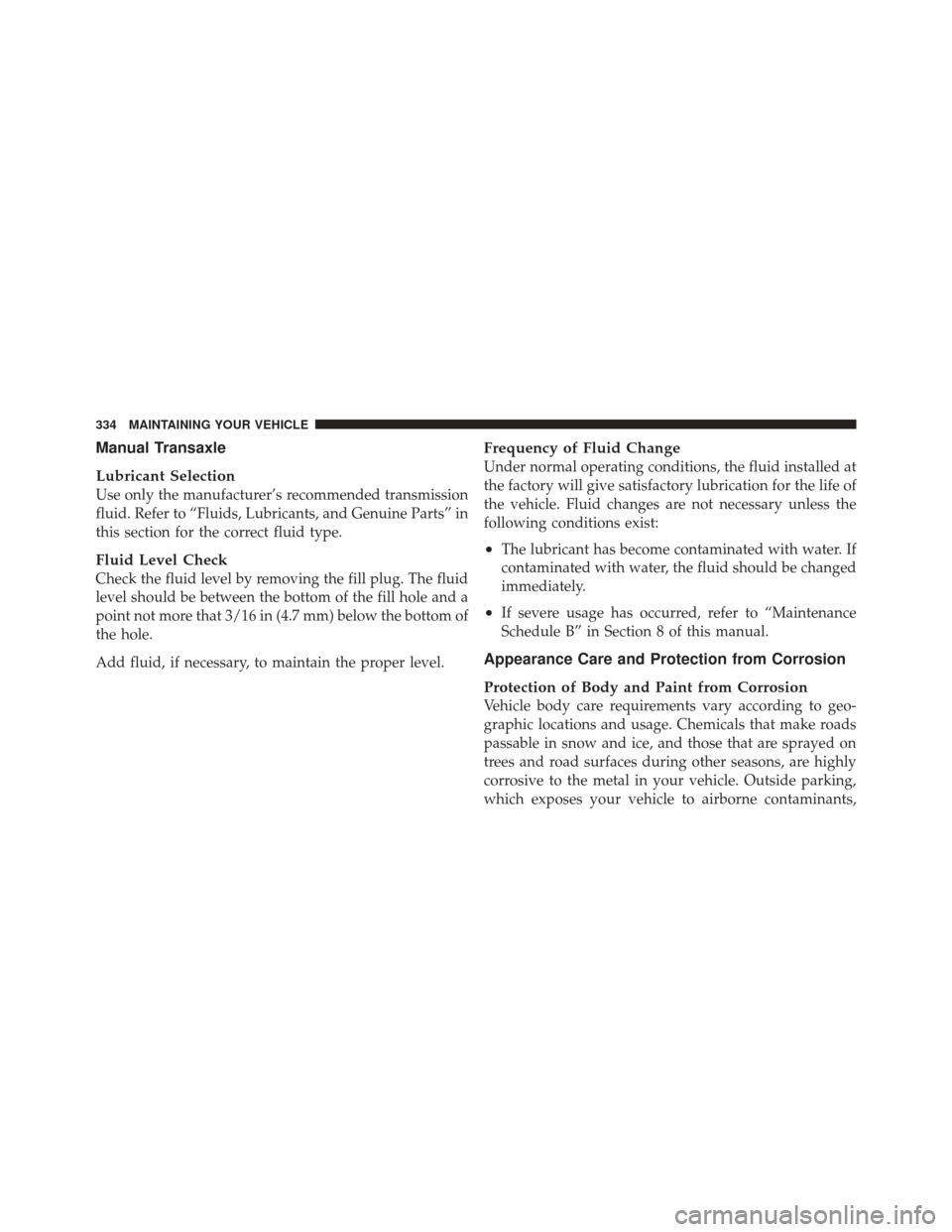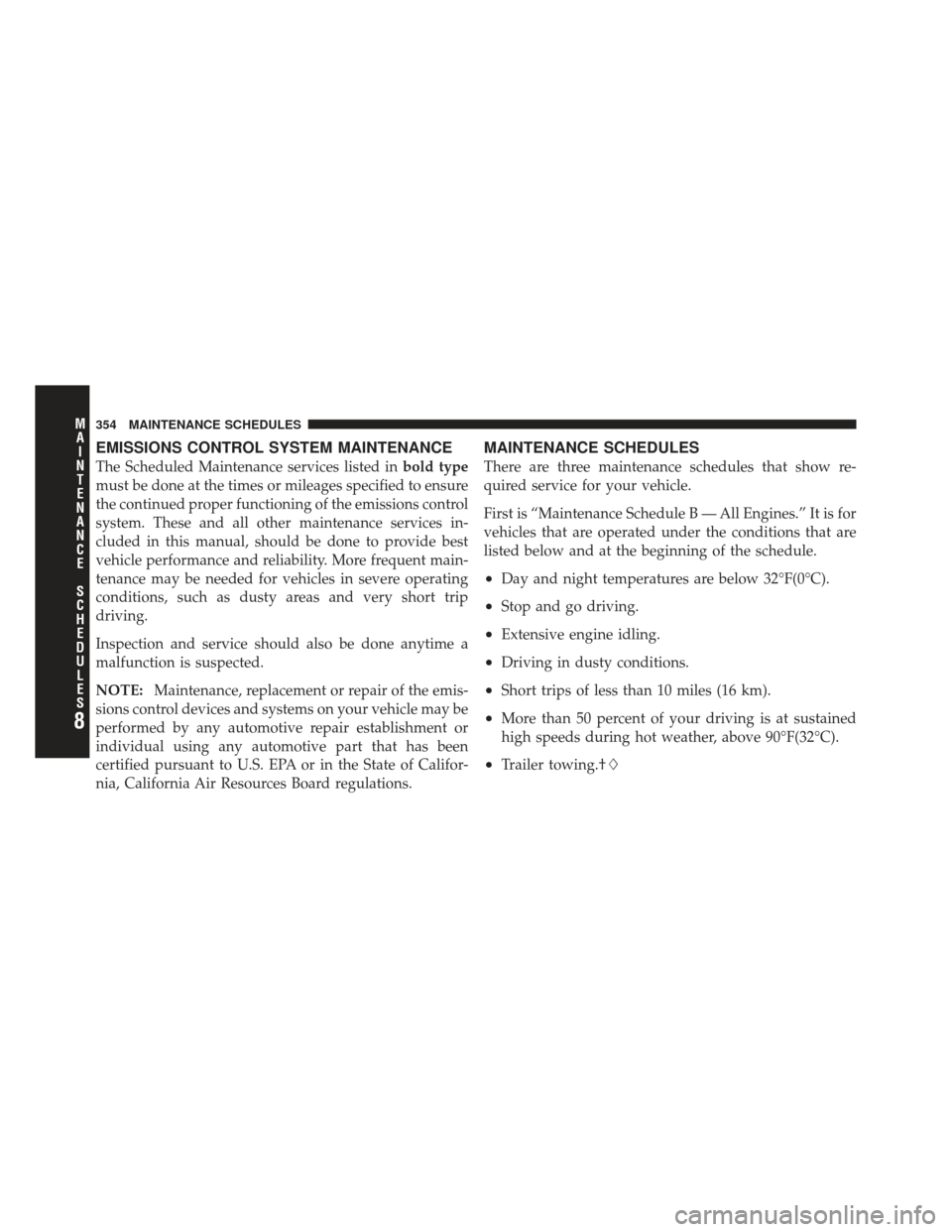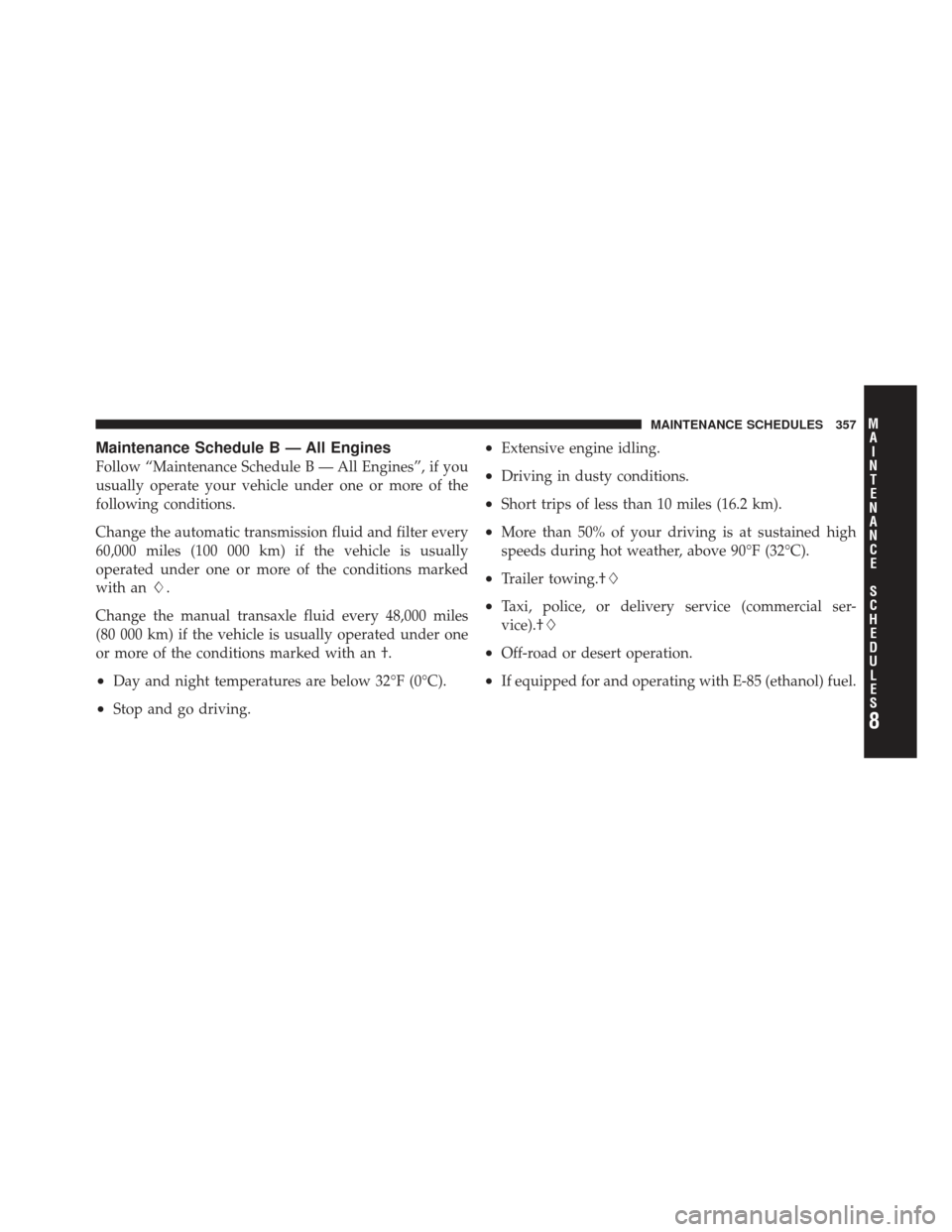Page 336 of 410

Manual Transaxle
Lubricant Selection
Use only the manufacturer’s recommended transmission
fluid. Refer to “Fluids, Lubricants, and Genuine Parts” in
this section for the correct fluid type.
Fluid Level Check
Check the fluid level by removing the fill plug. The fluid
level should be between the bottom of the fill hole and a
point not more that 3/16 in (4.7 mm) below the bottom of
the hole.
Add fluid, if necessary, to maintain the proper level.
Frequency of Fluid Change
Under normal operating conditions, the fluid installed at
the factory will give satisfactory lubrication for the life of
the vehicle. Fluid changes are not necessary unless the
following conditions exist:
•The lubricant has become contaminated with water. If
contaminated with water, the fluid should be changed
immediately.
•If severe usage has occurred, refer to “Maintenance
Schedule B” in Section 8 of this manual.
Appearance Care and Protection from Corrosion
Protection of Body and Paint from Corrosion
Vehicle body care requirements vary according to geo-
graphic locations and usage. Chemicals that make roads
passable in snow and ice, and those that are sprayed on
trees and road surfaces during other seasons, are highly
corrosive to the metal in your vehicle. Outside parking,
which exposes your vehicle to airborne contaminants,
334 MAINTAINING YOUR VEHICLE
Page 355 of 410
MAINTENANCE SCHEDULES
CONTENTS
�Emissions Control System Maintenance ...... 354
� Maintenance Schedules ................. 354
▫ At Each Stop For Fuel ................. 356
▫ Once a Month ...................... 356
▫ At Each Oil Change .................. 356 ▫
Maintenance Schedule B — All Engines .... 357
▫ Maintenance Schedule A — Non-
Turbocharged ....................... 368
▫ Maintenance Schedule A — Turbocharged . . . 373
8
M
A I
N T
E
N A
N CE
S
C
H E
D
U L
E
S
Page 356 of 410

EMISSIONS CONTROL SYSTEM MAINTENANCE
The Scheduled Maintenance services listed inbold type
must be done at the times or mileages specified to ensure
the continued proper functioning of the emissions control
system. These and all other maintenance services in-
cluded in this manual, should be done to provide best
vehicle performance and reliability. More frequent main-
tenance may be needed for vehicles in severe operating
conditions, such as dusty areas and very short trip
driving.
Inspection and service should also be done anytime a
malfunction is suspected.
NOTE: Maintenance, replacement or repair of the emis-
sions control devices and systems on your vehicle may be
performed by any automotive repair establishment or
individual using any automotive part that has been
certified pursuant to U.S. EPA or in the State of Califor-
nia, California Air Resources Board regulations.
MAINTENANCE SCHEDULES
There are three maintenance schedules that show re-
quired service for your vehicle.
First is “Maintenance Schedule B — All Engines.” It is for
vehicles that are operated under the conditions that are
listed below and at the beginning of the schedule.
•Day and night temperatures are below 32°F(0°C).
•Stop and go driving.
•Extensive engine idling.
•Driving in dusty conditions.
•Short trips of less than 10 miles (16 km).
•More than 50 percent of your driving is at sustained
high speeds during hot weather, above 90°F(32°C).
•Trailer towing.†
8
M A I
N T
E
N A
N CE
S
C
H E
D
U L
E
S354 MAINTENANCE SCHEDULES
Page 357 of 410

•Taxi, police, or delivery service (commercial ser-
vice).†
•Off-road or desert operation.
•If equipped for and operating with E-85 (ethanol) fuel.
NOTE:
•If ANY of these apply to you, then change your engine
oil every 3,000 miles (5 000 km) or three months,
whichever comes first, and follow “Maintenance
Schedule B — All Engines” in this section.
•If ANY of these apply to you, then flush and replace
the engine coolant every 102,000 miles (170 000 km) or
60 months, whichever comes first, and follow “Main-
tenance Schedule B — All Engines” in this section.
•Most vehicles are operated under the conditions listed
for “Maintenance Schedule B — All Engines.” Second is “Maintenance Schedule A — Non-
Turbocharged.” It is for vehicles that are not operated
under any of the conditions listed under “Maintenance
Schedule B — All Engines.”
Third is Maintenance Schedule A — Turbocharged. It is
for vehicles that are not operated under any of the
conditions listed under “Maintenance Schedule B — All
Engines.”
Use the schedule that best describes your driving condi-
tions. Where time and mileage are listed, follow the
interval that occurs first.
CAUTION!
Failure to perform the required maintenance items
may result in damage to the vehicle.8
M
A I
N T
E
N A
N CE
S
C
H E
D
U L
E
SMAINTENANCE SCHEDULES 355
Page 358 of 410

At Each Stop for Fuel
•
Check the engine oil level about five minutes after a
fully warmed engine is shut off. Checking the oil level
while the vehicle is on level ground will improve the
accuracy of the oil level reading. Add oil only when
the level is at or below the ADD or MIN mark.
•Check the windshield washer solvent and add if
required.
Once a Month
•
Check tire pressure and look for unusual wear or
damage.
•Inspect the battery and clean and tighten the terminals
as required.
•Check the fluid levels of coolant reservoir, brake
master cylinder and transaxle, and add as needed.
•Check all lights and all other electrical items for correct
operation.
•Check rubber seals on each side of the radiator for
proper fit.
At Each Oil Change
•
Change the engine oil filter.
•Inspect the exhaust system.
•Inspect the brake hoses.
•Inspect the CV joints and front suspension compo-
nents.
•Check the automatic transaxle fluid level.
•Check the manual transaxle fluid level and fill plug
condition.
•Check the coolant level, hoses, and clamps.
8
MA I
N T
E
N A
N CE
S
C
H E
D
U L
E
S356 MAINTENANCE SCHEDULES
Page 359 of 410

Maintenance Schedule B — All Engines
Follow “Maintenance Schedule B — All Engines”, if you
usually operate your vehicle under one or more of the
following conditions.
Change the automatic transmission fluid and filter every
60,000 miles (100 000 km) if the vehicle is usually
operated under one or more of the conditions marked
with an .
Change the manual transaxle fluid every 48,000 miles
(80 000 km) if the vehicle is usually operated under one
or more of the conditions marked with an †.
•Day and night temperatures are below 32°F (0°C).
•Stop and go driving.
•Extensive engine idling.
•Driving in dusty conditions.
•Short trips of less than 10 miles (16.2 km).
•More than 50% of your driving is at sustained high
speeds during hot weather, above 90°F (32°C).
•Trailer towing.†
•Taxi, police, or delivery service (commercial ser-
vice).†
•Off-road or desert operation.
•If equipped for and operating with E-85 (ethanol) fuel.
8
M A I
N T
E
N A
N CE
S
C
H E
D
U L
E
SMAINTENANCE SCHEDULES 357
Page 360 of 410
NOTE:
•IfANY of these apply to you, then change your engine
oil every 3,000 miles (5 000 km) or three months,
whichever comes first, and follow ’Maintenance
Schedule B — All Engines”in this section.
•If ANY of these apply to you, then flush and replace
the engine coolant every 102,000 miles (170 000 km) or
60 months, whichever comes first, and follow “Main-
tenance Schedule B — All Engines” in this section. If none of these apply to you, and your vehicle is
equipped with a Non–Turbocharged engine, then change
your engine oil at every interval shown on “Maintenance
Schedule A — Non–Turbocharged” in this section.
If none of these apply to you, and your vehicle is
equipped with a Turbocharged engine change your en-
gine oil at every interval shown on “Maintenance Sched-
ule A — Turbocharged” in this section.
8
M
A I
N T
E
N A
N CE
S
C
H E
D
U L
E
S358 MAINTENANCE SCHEDULES
Page 361 of 410
Miles3,000 6,000 9,000 12,000 15,000 18,000
(Kilometers) (5 000) (10 000) (15 000) (20 000) (25 000) (30 000)
Change engine oil and engine oil filter, if not
replaced at three months. XXXXX X
Rotate tires. XX X
Inspect the brake linings. X
Inspect the engine air cleaner filter, replace as
necessary. * X
Inspect the make-up air filter, replace as
necessary.* X
8
M
A I
N T
E
N A
N CE
S
C
H E
D
U L
E
SMAINTENANCE SCHEDULES 359